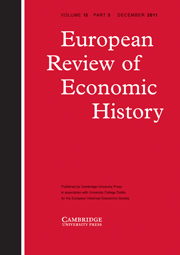Crossref Citations
This article has been cited by the following publications. This list is generated based on data provided by
Crossref.
Fenske, James
2010.
THE CAUSAL HISTORY OF AFRICA: A RESPONSE TO HOPKINS.
Economic History of Developing Regions,
Vol. 25,
Issue. 2,
p.
177.
Du Plessis, Sophia
and
Du Plessis, Stan
2012.
Happy in the Service of the Company: The Purchasing Power of VOC Salaries at the Cape in the 18th Century.
Economic History of Developing Regions,
Vol. 27,
Issue. 1,
p.
125.
Rota, M.
2013.
Credit and growth: reconsidering Italian industrial policy during the Golden Age.
European Review of Economic History,
Vol. 17,
Issue. 4,
p.
431.
Fourie, Johan
and
van Zanden, Jan Luiten
2013.
GDP in the Dutch Cape Colony: The National Accounts of a Slave‐Based Society.
South African Journal of Economics,
Vol. 81,
Issue. 4,
p.
467.
FOURIE, JOHAN
2013.
The remarkable wealth of the Dutch Cape Colony: measurements from eighteenth‐century probate inventories1.
The Economic History Review,
Vol. 66,
Issue. 2,
p.
419.
Lampe, Markus
and
Sharp, Paul
2014.
Handbook of Cliometrics.
p.
1.
Green, Erik
2014.
The Economics of Slavery in the Eighteenth-Century Cape Colony: Revising the Nieboer-Domar Hypothesis.
International Review of Social History,
Vol. 59,
Issue. 01,
p.
39.
Fourie, Johan
and
von Fintel, Dieter
2014.
Settler skills and colonial development: the Huguenot wine‐makers in eighteenth‐century Dutch South Africa.
The Economic History Review,
Vol. 67,
Issue. 4,
p.
932.
Thompsell, Angela
2015.
Hunting Africa.
p.
12.
Du Plessis, Sophia
Jansen, Ada
and
von Fintel, Dieter
2015.
Slave prices and productivity at the Cape of Good Hope from 1700 to 1725: Did everyone win from the trade?.
Cliometrica,
Vol. 9,
Issue. 3,
p.
289.
Baten, Jörg
and
Fourie, Johan
2015.
Numeracy of Africans, Asians, and Europeans during the early modern period: new evidence from Cape Colony court registers.
The Economic History Review,
Vol. 68,
Issue. 2,
p.
632.
Lampe, Markus
and
Sharp, Paul
2016.
Handbook of Cliometrics.
p.
295.
Farrell, Greg
and
Kemp, Esti
2017.
Measuring the Financial Cycle in South Africa.
SSRN Electronic Journal ,
Boshoff, W.H.
and
Fourie, J.
2017.
When did South African Markets Integrate into the Global Economy?.
Studies in Economics and Econometrics,
Vol. 41,
Issue. 1,
p.
19.
Fourie, J.
2018.
Cliometrics in South Africa.
Studies in Economics and Econometrics,
Vol. 42,
Issue. 2,
p.
1.
Boshoff, Willem H.
and
McLean, Lewis
2018.
What do deviation cycles measure? An analysis of the informational content of filter-based business cycles.
South African Journal of Economic and Management Sciences,
Vol. 21,
Issue. 1,
de Zwart, Pim
and
van Zanden, Jan Luiten
2018.
The Origins of Globalization.
Vink, Nick
Boshoff, Willem H.
Fourie, Johan
and
van Jaarsveld, Rossouw
2018.
Wine Cycles in South Africa.
Journal of Wine Economics,
Vol. 13,
Issue. 2,
p.
182.
Vink, Nick
2019.
The Palgrave Handbook of Wine Industry Economics.
p.
201.
Fourie, Johan
and
Obikili, Nonso
2019.
Handbook of Cliometrics.
p.
1.


